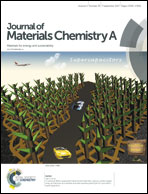Flexible MXene–graphene electrodes with high volumetric capacitance for integrated co-cathode energy conversion/storage devices†
Abstract
Developing self-powered integrated energy conversion and storage devices (ECSDs) is regarded as a promising approach to meet the quickly increasing demand for portable and wearable electronics. In this work, we describe a concept of using reduced graphene oxide (rGO) as a binder bridging electrochemically active conducting particles and enabling the manufacturing of flexible all-solid-state rGO/Ti3C2Tx (MXene) film-based supercapacitors. These supercapacitors were integrated with flexible thin-film solar cells by the co-cathode method to fabricate ECSDs. The porous rGO/Ti3C2Tx films were produced by vacuum-assisted filtration of the GO/Ti3C2Tx dispersion, followed by reduction at 300 °C under vacuum. This approach eliminated the need for the delamination of MXenes and allowed for the manufacturing of thick electrodes with good electrolyte accessibility. The volumetric and gravimetric capacitance of the rGO/Ti3C2Tx film in 6 M KOH reached 370 F cm−3 and 405 F g−1, respectively, which can be related to the synergistic effect of rGO and Ti3C2Tx. The assembled all-solid-state supercapacitors (SCs) using the polyvinyl alcohol (PVA)/KOH gel electrolyte exhibited a high energy density of 63 mW h cm−3 at a power density of 0.06 W cm−3. Their capacitance did not change after 10 000 charge/discharge cycles at the current density of 5 A g−1, ensuring stable performance of the ECSDs.



 Please wait while we load your content...
Please wait while we load your content...